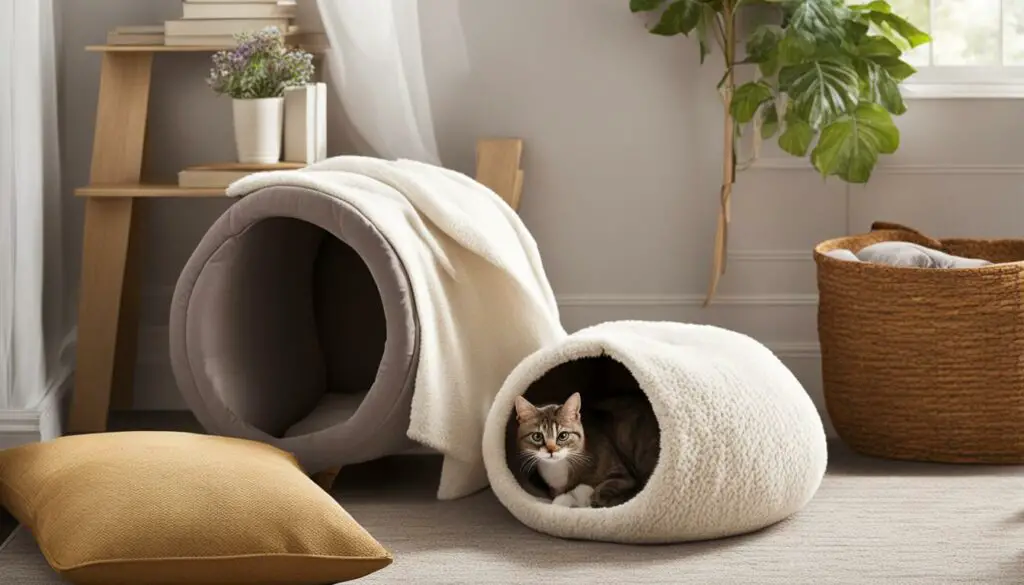Gaining the trust of a scared kitten can be a challenge, but with patience and understanding, you can help them overcome their fears and build a strong bond. As a feline friend, it’s important to create a calm and comforting environment for your new kitten, providing them with the reassurance they need to feel safe and secure.
Key Takeaways:
- My new kitten is scared of me? Don’t worry, it’s common and can be overcome.
- Building trust takes time and patience, so provide a calm and comforting environment.
- Positive experiences and gentle reassurance are essential for helping scared kittens overcome their fears.
- Socialization, routine, and gradual exposure to new experiences can help your kitten gain confidence.
- Creating a dedicated safe space and using calming solutions can provide comfort and reduce anxiety.
Why Is My Kitten So Scared?
Kittens may display fear and shyness due to their small size and the new and unfamiliar world around them. This can be a natural response as they navigate their surroundings and learn to adapt to new experiences. Socialization plays a crucial role in helping kittens overcome their fears and build confidence.
During their prime socialization period, which occurs between 2 and 7 weeks of age, kittens are more receptive to positive experiences and less likely to develop excessive fear. Positive interactions with humans, other animals, and various environments can help them feel secure and less prone to fearfulness later in life.
The socialization period between 2 and 7 weeks of age is a critical time for kittens to establish positive associations with their environment and reduce the likelihood of developing excessive fear and shyness.
By providing a safe and nurturing environment for your kitten, along with gradual exposure to new stimuli and positive reinforcement, you can help them feel more at ease and confident. Understanding the reasons behind their fear and taking proactive steps to address it can pave the way for a happy and well-adjusted feline friend.

Why Is Early Socialization Important?
Early socialization is crucial for kittens because it helps them form positive associations with people, other animals, and their environment. It allows them to learn how to navigate their surroundings and adapt to new experiences, reducing the likelihood of developing excessive fear and shyness later in life. Socialization also helps kittens build confidence, trust, and resilience.
| Benefits of Early Socialization | Examples |
|---|---|
| Reduced fear and anxiety | A kitten who has been socialized properly is less likely to exhibit fear-based behaviors, such as hiding or aggression, in unfamiliar situations. |
| Better social skills | A well-socialized kitten is more likely to get along with people and other animals, making them more adaptable and comfortable in various social settings. |
| Increased confidence | Socialized kittens are more confident in exploring their environment and approaching new experiences, which can foster their overall well-being. |
| Improved health and safety | Kittens who have positive experiences with handling and veterinary care during socialization are more likely to be cooperative and less stressed during medical procedures. |
What If I Missed the Socialization Window?
If your kitten has missed the prime socialization window, don’t worry. It is still possible to help them overcome their fears and build a strong bond with you. Building trust with a shy or fearful kitten requires patience and consistency. Here are some tips to help you navigate this process:
Gentle Petting and Positive Reinforcement
Start by offering gentle and slow petting to your kitten, allowing them to set the pace. Avoid sudden movements or loud noises that may startle them. Over time, they will start to associate your touch with comfort and security. Additionally, reward them with treats or praise when they show signs of relaxation or bravery. Positive reinforcement goes a long way in building trust and confidence.
Create a Routine
Kittens thrive on routine, as it provides a sense of predictability and security. Establish a consistent daily schedule for feeding, playtime, and rest. This routine will help your kitten feel more at ease and reduce their anxiety. Consistency is key in reassuring your scared kitten that they are in a safe and stable environment.
Bonding Activities
Engage in bonding activities that promote trust and connection. Play interactive games using toys to stimulate their natural instincts and build confidence. Encourage gentle play and avoid any rough behavior that may scare them further. Spending quality time together in a calm and relaxed environment will gradually strengthen your bond.
Remember, every kitten is unique, and progress may take time. Be patient, understanding, and supportive. With your love and care, your shy or fearful kitten will slowly come out of their shell and learn to trust you.

6 Tips to Help Your Kitten Overcome Their Fear
If you have a scared kitten, it’s important to provide them with the right guidance and support to help them overcome their fears and build confidence. Here are six tips to help your kitten overcome their fear:
- Stick to a Schedule: Establishing a consistent daily routine can help your kitten feel more secure. Feed them at the same time each day, play with them, and provide regular quiet time for rest and relaxation.
- Introduce New Experiences Gradually: Expose your kitten to new experiences and environments slowly and gently. Start with small steps, such as introducing them to different types of toys or new sounds in a controlled environment.
- Reward Bravery: When your kitten shows signs of bravery, such as exploring a new area or approaching a new person, reward them with treats and praise. Positive reinforcement will help them associate these new experiences with positive outcomes.
- Remove Them from Overwhelming Situations: If your kitten becomes overwhelmed or scared, gently remove them from the situation and bring them to a quiet and familiar space. Allow them time to calm down and regain their composure.
- Provide Comfort and Reassurance: When your kitten is feeling scared, it’s essential to offer them comfort and reassurance. Provide a cozy and safe space for them to retreat to, with soft bedding and familiar scents.
- Redirect Their Attention: If your kitten is displaying fearful behavior, redirect their attention to something positive. Engage them in play or offer them a favorite toy to help distract and shift their focus away from their fear.
Remember, every kitten is unique, and it may take time for them to overcome their fears. Be patient, understanding, and consistent in your efforts to help them feel safe and secure.

Additional Resources
“The way to overcome fear is to face it head-on with love and patience.” – Unknown
For more information on helping scared kittens, consider consulting with a veterinarian or a professional animal behaviorist. They can provide personalized advice and guidance based on your kitten’s specific needs and circumstances.
Creating a Calm Environment for Your Kitten
When it comes to helping a scared kitten overcome their fears, creating a calm environment is essential. By providing a safe place for them to retreat and ensuring a peaceful atmosphere, you can help your kitten feel secure and relaxed.
The first step is to designate a resting area specifically for your scared kitten. This could be a small den or cozy corner where they can feel protected. Make sure to place comfortable bedding and familiar scents in their resting area to provide a sense of security.
Additionally, it’s important to respect your kitten’s no-touch zone. This is an area where they can retreat when they need privacy and space. By giving them the freedom to choose when and how they interact with you, you can build trust and help them feel more at ease.
| Creating a Calm Environment for Your Kitten | |
|---|---|
| Provide a designated resting area | Offer a comfortable space with bedding and familiar scents |
| Respect their no-touch zone | Allow them to have privacy and space when needed |
Remember to maintain a peaceful and quiet environment for your scared kitten. Minimize loud noises and sudden movements, as these can contribute to their fear and anxiety. By creating a calm and safe space, you are laying the foundation for your kitten to gradually overcome their fears and become more confident in their surroundings.

Maintaining a Calm Environment
When it comes to maintaining a calm environment, consistency is key. Stick to a regular routine and provide your kitten with predictable experiences. This will help them feel secure and in control, reducing their fear and anxiety.
- Stick to a consistent schedule for feeding, playtime, and quiet time
- Minimize exposure to stressful situations or loud noises
- Introduce new experiences gradually and at their own pace
“By creating a calm and safe space, you are laying the foundation for your kitten to gradually overcome their fears and become more confident in their surroundings.”
By following these tips and creating a calm environment for your scared kitten, you can help them feel safe, secure, and ultimately overcome their fears. Remember to be patient and allow your kitten to progress at their own pace. With time and love, they will grow into a confident and happy feline friend.
Calming Solutions for Kittens
If your kitten is scared or anxious, there are several calming solutions that can help them feel more secure and at ease. These solutions can create a sense of comfort and reduce stress and anxiety in your furry friend.
One effective solution is the use of pheromone diffusers. These diffusers release synthetic pheromones that mimic the natural calming scents produced by mother cats. The pheromones can help create a familiar and safe environment for your kitten, making them feel more relaxed.
Heated mats are another great option for calming scared kittens. The warmth from the mat can provide a sense of comfort and security, similar to the feeling of being cuddled up with their mother. Just make sure to choose a mat specifically designed for cats to ensure their safety.

Quotes:
“Calming solutions such as pheromone diffusers and heated mats can help alleviate fear and anxiety in kittens.” – Pet Behavior Expert
In addition to pheromone diffusers and heated mats, soothing sounds can also help calm your frightened kitten. Playing gentle music or using white noise machines can provide a calming atmosphere and drown out any loud or sudden noises that may startle your kitten.
Lastly, providing hiding places for your kitten can give them a safe retreat when they feel scared. This can be as simple as providing cardboard boxes, tunnels, or cozy blankets for them to hide and feel protected.
| Calming Solutions for Kittens |
|---|
| Pheromone Diffusers |
| Heated Mats |
| Soothing Sounds |
| Hiding Places |
How to Know if Your Cat Is Nervous or Afraid
Recognizing the signs of fear in your cat is crucial in addressing their anxiety and providing appropriate support. Cats can display various behaviors when they are nervous or afraid. Here are some common signs to look out for:
Signs of Fear:
- Freezing: Cats may become completely still when they feel scared or threatened.
- Hiding: They may seek out hiding spots, such as under furniture or in enclosed spaces, to feel safe.
- Wide eyes: When a cat is fearful, their eyes may appear large and round.
- Hissing: Cats may hiss as a defensive reaction when they feel threatened.
- Scratching: If a cat is scared, they may scratch objects or people as a way to protect themselves.
- Toileting outside the litter tray: Cats experiencing fear or anxiety may have accidents outside their regular litter tray.
By being observant of these signs, you can better understand your cat’s emotions and take appropriate steps to help them feel more secure and comfortable.

How to Find Out What Is Frightening Your Cat
It can be a challenge to identify what is causing fear in your cat, as they can be scared of various things. However, by observing their behavior and identifying patterns, you can start to determine the sources of their fear and take appropriate steps to address them.
One way to identify fear triggers is to watch for signs of fear in your cat’s body language and behavior. Cats may display signs such as freezing, hiding, wide eyes, hissing, scratching, or toileting outside the litter tray when they are nervous or afraid. These behaviors can give you clues about what is causing their fear.
Another method is to create a fear journal, where you document any potentially fear-inducing situations or events that occur around your cat. This can help you identify patterns and pinpoint specific triggers. For example, you may notice that your cat becomes fearful every time there is loud noise or when new people come to your home.
Additionally, seeking the help of a professional, such as a veterinarian or animal behaviorist, can provide valuable insight into your cat’s fears. They can conduct a thorough evaluation and provide guidance on how to address the specific triggers causing fear in your cat.
| Possible Fear Triggers | Signs of Fear |
|---|---|
| Loud noises | Freezing, hiding, wide eyes |
| New people or animals | Hissing, scratching |
| Visits to the veterinarian | Panting, trembling |
| Handling or grooming | Attempts to escape, aggression |
By actively observing your cat’s behavior and taking note of potential triggers, you can begin to identify what is frightening them. This knowledge will be instrumental in helping you develop a targeted approach to address their fears and create a more comfortable and secure environment for your feline friend.

Quote:
“Understanding what scares your cat is the first step towards helping them overcome their fears and live a happier, more confident life.”
How to Help a Scared or Anxious Cat
When it comes to helping a scared or anxious cat, several strategies can effectively reduce stress and promote a sense of calm. Here are some tips and techniques that can make a difference:
- Reducing stress: Creating a peaceful and low-stimulus environment can greatly benefit a scared cat. Minimize loud noises and disturbances, and provide a secluded space where they can retreat when feeling overwhelmed.
- Providing space: Cats need their personal space, especially when they’re feeling anxious. Make sure to respect their boundaries and avoid approaching them when they seek solitude. Giving them enough room to feel safe and secure is crucial.
- Avoiding triggers: Identify and eliminate any triggers that may be causing fear or anxiety in your cat. This could include specific sounds, objects, or situations. By removing these triggers from their environment, you can help create a more peaceful and relaxed atmosphere.
- Staying calm: Cats are highly attuned to their owners’ emotions. By remaining calm and composed, you can help your cat feel more at ease. Avoid raising your voice or displaying anxious behavior, as this can further exacerbate their fear.
- Establishing a routine: Cats thrive on routine and predictability. By establishing a consistent daily schedule for feeding, playtime, and relaxation, you can provide them with a sense of security and stability.
- Desensitization: Gradual exposure to fearful situations or stimuli can help desensitize a scared cat over time. This can be done by gradually introducing them to the trigger in small, controlled doses while providing positive reinforcement and rewards for calm behavior.
Remember, every cat is unique, and it may take time and patience to find the right approach for your furry friend. If your cat continues to struggle with fear or anxiety, it’s always a good idea to consult with a veterinarian or a professional animal behaviorist for guidance and support.

Table: Common Fear and Anxiety Triggers in Cats
| Trigger | Description |
|---|---|
| Loud Noises | Thunderstorms, fireworks, or household appliances can startle and frighten cats. |
| Strangers | Cats may become anxious or fearful when encountering unfamiliar people or animals. |
| Veterinary Visits | The unfamiliar sounds, smells, and handling during vet visits can trigger fear and anxiety in cats. |
| Changes in Environment | Moving to a new home or rearranging furniture can disrupt a cat’s sense of security and trigger fear. |
| Confinement | Being trapped or confined in a small space can induce fear and anxiety in cats. |
Understanding and addressing the underlying causes of fear and anxiety in cats is essential for their well-being and happiness. By implementing these strategies, you can provide a supportive and nurturing environment that helps your cat feel safe and secure.
De-Sensitization Techniques for Cats
De-sensitization techniques are an effective way to help cats overcome their fears and anxieties. By gradually exposing them to their fear triggers in a controlled and positive manner, cats can learn to associate these triggers with positive experiences, reducing their fear over time.
One technique is behavior modification, which involves gradually exposing the cat to their fear trigger in a safe and controlled environment. For example, if a cat is afraid of loud noises, you can start by playing a low-volume recording of the noise and gradually increase the volume over time. During these sessions, it’s important to create a calm and comfortable environment for the cat, offering treats and rewards to associate the trigger with positive outcomes.
Positive exposure is another valuable technique. This involves gradually introducing the cat to the fear trigger by providing positive experiences alongside it. For instance, if a cat is scared of strangers, you can invite a trusted friend to the house and have them offer treats or play with the cat. This helps the cat associate strangers with positive interactions and reduces their fear over time.
| De-Sensitization Techniques for Cats | Benefits |
|---|---|
| Behavior modification | – Gradual exposure to fear triggers – Positive association with rewards – Reduction of fear over time |
| Positive exposure | – Introduction of fear triggers with positive experiences – Association of fear triggers with positive interactions – Reduction of fear over time |
A gradual approach is crucial when using de-sensitization techniques. It’s important to start with small, manageable steps and gradually increase the intensity or proximity of the fear trigger as the cat becomes more comfortable. Pushing too quickly can cause the cat to become more fearful or stressed, which can hinder progress.
Remember, de-sensitization techniques should be implemented with patience and consistency. It may take time for cats to overcome their fears, and each cat will progress at their own pace. If you are unsure about how to proceed or if your cat’s fear persists, consulting a veterinarian or animal behaviorist can provide additional guidance and support.

Does My Cat Need Medication to Help with Fear and Anxiety?
When it comes to helping a scared or anxious cat, there may be instances where medication is necessary to alleviate their fear and anxiety. It is important to consult with a veterinarian or behaviorist to determine the best course of action for your cat’s specific needs. Medication should always be used in conjunction with behavioral treatment and under professional guidance.
A veterinarian or behaviorist can evaluate your cat’s behavior and recommend appropriate medication if deemed necessary. They will consider factors such as the severity of your cat’s fear and anxiety, any underlying medical conditions, and the potential benefits and risks of medication. It’s important to follow their guidance and strictly adhere to the prescribed dosage and treatment plan.
Medication can help reduce your cat’s fear and anxiety, making it easier for them to engage in behavioral modification techniques. It can provide temporary relief and create a calmer state, enabling your cat to learn and adapt to new experiences and gradually overcome their fears. However, it is essential to remember that medication alone will not solve the underlying issues, and behavioral intervention is still crucial for long-term improvement.
Remember, each cat is unique, and their response to medication may vary. It’s important to closely monitor your cat’s behavior and consult with your veterinarian or behaviorist regularly to ensure the medication is working effectively and adjust the treatment plan if needed. With the right combination of medication and behavioral intervention, you can help your cat overcome their fear and anxiety, leading to a happier and more relaxed feline companion.

Expert Quote:
“Medication can be a useful tool in helping cats with severe fear and anxiety. However, it is important to remember that it should always be used in conjunction with behavioral treatment and under the guidance of a veterinarian or behaviorist.” – Dr. Samantha Johnson, Veterinary Behaviorist
Building a Den for Your Cat
Creating a den for your cat can provide them with a safe space and hiding spot when they are scared. Cats are naturally territorial animals and having a designated den can help them feel secure and in control of their environment. It’s important to set up the den in a quiet area of your home where your cat can retreat to when they need time alone.
You can create a den using furniture or blankets, but there are also specialized cat den options available for purchase. These dens are often designed specifically to provide a cozy and enclosed space for cats. They can have multiple entrances and exits, as well as comfortable padding inside for added comfort.
When setting up the den, make sure to place it in a location that your cat feels comfortable in. This could be a corner of a room or a quiet area where they won’t be disturbed. Additionally, you can add some familiar scents, such as bedding or toys, to help make the den feel even more secure for your cat.

Benefits of a Cat Den
A cat den provides several benefits for your feline friend. Firstly, it gives them a sense of ownership and control over their environment. This can help reduce their anxiety and fear, as they have a safe space they can retreat to whenever they feel overwhelmed.
Furthermore, a cat den can also serve as a place to relax and rest. Cats, by nature, enjoy small and enclosed spaces as it makes them feel secure. Providing them with a den allows them to have a designated resting area where they can feel safe and comfortable.
Lastly, a cat den can also help with introductions to new pets or visitors. If your cat is feeling wary or scared of unfamiliar animals or people, they can use the den as a sanctuary. This allows them to observe and interact at their own pace, gradually building their confidence and trust.
Conclusion
Creating a den for your cat is a simple yet effective way to provide them with a safe space and hiding spot. By offering a designated area where they can retreat to when they feel scared, you can help reduce their anxiety and build their confidence. Whether you choose to use furniture, blankets, or a specialized cat den, the key is to create a comfortable and secure environment where your cat can feel at ease.
Conclusion
Overcoming fear in cats is a gradual process that involves building trust, creating a calm environment, and understanding their fears. By providing positive experiences and gentle reassurance, we can help scared kittens and cats feel safe and secure.
Creating a calm environment for our furry friends involves offering them a dedicated safe space with familiar scents and hiding spots. Respecting their need for privacy and providing a comfortable resting area can go a long way in reducing their fear and anxiety.
Understanding the signs of fear in cats, such as freezing, hiding, wide eyes, or hissing, is crucial in addressing their fears. By identifying fear triggers and avoiding them when possible, we can help our cats feel more comfortable and relaxed.
Ultimately, overcoming fear in cats requires patience, empathy, and sometimes professional help. By employing desensitization techniques, gradually exposing them to their fears in a controlled and positive manner, we can help our beloved feline companions build trust and conquer their fears.
FAQ
Why is my kitten so scared?
Kittens can often experience fear and shyness due to their small size and the new and unfamiliar world around them. Proper socialization and positive experiences can help them overcome their fears.
What if I missed the socialization window for my kitten?
If you missed the prime socialization window, it is still possible to help your kitten overcome their fears. Continued positive experiences, socialization, and a routine can gradually build trust and strengthen the bond between you and your kitten.
What are some tips to help my scared kitten overcome their fear?
Here are six tips to help your scared kitten: create a routine, introduce new experiences gradually, reward bravery, remove them from overwhelming situations, provide comfort and reassurance, and redirect their attention.
How can I create a calm environment for my scared kitten?
You can create a calm environment for your scared kitten by providing a dedicated safe space, offering a comfortable resting area, and respecting their no-touch zone when they seek privacy.
Are there any calming solutions for scared kittens?
Yes, you can use pheromone diffusers, heated mats, soothing sounds, and provide hiding places to help calm your scared kitten. These solutions can create a sense of security and comfort, reducing their stress and anxiety.
How can I know if my cat is nervous or afraid?
Signs of fear in cats include freezing, hiding, wide eyes, hissing, scratching, and toileting outside the litter tray. These behaviors indicate that your cat is nervous or afraid and may require help to overcome their fears.
How can I find out what is frightening my cat?
Identifying what is causing fear in your cat can be challenging, but by observing their behavior and identifying patterns, it is possible to determine the sources of their fear and take appropriate steps to address them.
How can I help a scared or anxious cat?
To help a scared or anxious cat, it is important to create a stress-free environment, provide a safe space, avoid triggers, stay calm, establish a routine, and consider desensitization techniques. These strategies can help the cat feel more comfortable and reduce their fear and anxiety.
What are de-sensitization techniques for cats?
De-sensitization techniques involve gradually exposing a cat to their fear in a controlled and positive way. By gradually increasing exposure and providing rewards, the cat can learn to associate the fear trigger with positive experiences and reduce their fear over time.
Does my cat need medication to help with fear and anxiety?
Some cats may require medication alongside behavioral treatment for severe fear and anxiety. It is important to consult with a veterinarian or behaviorist to determine if medication is necessary and to ensure the proper dosage and treatment plan.
How can I build a den for my cat?
You can build a den for your cat by using furniture, blankets, or purchasing specialized cat den options. This will provide them with a safe space and hiding spot when they are scared.
Source Links
- https://be.chewy.com/help-your-scared-kitten-overcome-fear/
- https://www.thesprucepets.com/building-confidence-in-fearful-cats-555505
- https://www.pdsa.org.uk/pet-help-and-advice/looking-after-your-pet/kittens-cats/how-to-help-a-nervous-cat








